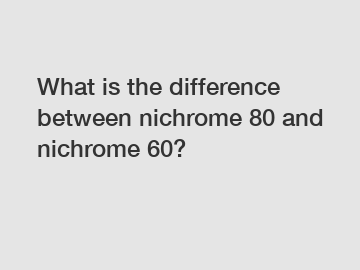What is the difference between nichrome 80 and nichrome 60?
Nichrome is a popular alloy that is widely used in various heating applications, including heating elements, electric furnaces, and resistance wires. It is known for its high electrical resistance and excellent heat resistance properties. Two common variations of nichrome that are often compared are nichrome 80 and nichrome 60. In this article, we will explore the key differences between nichrome 80 and nichrome 60 and understand their respective characteristics.
Composition.
Nichrome 80, also known as N80, consists of 80% nickel and 20% chromium. On the other hand, nichrome 60, known as N60, is made up of 60% nickel and 16% chromium. The remaining percentages of both alloys are typically iron and other trace elements. This difference in composition directly influences their electrical and thermal properties.

Electrical and Thermal Properties.
Nichrome 80 has a higher electrical resistivity compared to nichrome 60. This means that it offers a greater resistance to the flow of electric current. As a result, nichrome 80 generates more heat when an electric current passes through it. It is ideal for applications where high temperatures are required, such as in industrial furnaces and kilns.
Nichrome 60, on the other hand, has a slightly lower electrical resistivity. This makes it suitable for applications where a lower level of heat is desired, such as in heating coils for home appliances like toasters and hair dryers. Nichrome 60 is known for its fast heating and cooling capabilities due to its lower electrical resistance.
Temperature Range.
Another significant difference between nichrome 80 and nichrome 60 lies in their temperature ratings. Nichrome 80 is designed to withstand higher temperatures compared to nichrome 60. It can operate effectively at temperatures reaching up to 2150°F (1180°C) and is known to have a higher melting point. Nichrome 60, on the other hand, has a lower temperature rating and can typically handle temperatures up to 1900°F (1040°C). Therefore, if you have an application that requires higher temperatures, nichrome 80 would be the preferred choice.
Corrosion Resistance.
Both nichrome 80 and nichrome 60 offer good corrosion resistance due to the presence of chromium in their composition. However, nichrome 80 tends to have better corrosion resistance properties compared to nichrome 60. This makes nichrome 80 more durable and suitable for long-term use in aggressive environments or applications where exposure to corrosive substances is likely.
Applications.
The choice between nichrome 80 and nichrome 60 depends on the specific requirements of a heating application. Nichrome 80 is commonly used in high-temperature environments like industrial furnaces, kilns, and heating elements for manufacturing processes. Nichrome 60, with its lower temperature rating and faster heating properties, finds its application in home appliances, heating coils, and other residential or commercial heating systems.
Conclusion.
In conclusion, the primary differences between nichrome 80 and nichrome 60 lie in their composition, electrical and thermal properties, temperature ratings, and corrosion resistance. The choice between the two alloys depends on the specific heating requirements of an application. Nichrome 80 is suitable for high-temperature environments, while nichrome 60 is ideal for applications requiring lower temperatures. It is important to consider these factors to ensure optimal performance and longevity of the heating equipment.
If you have any further questions or require assistance in selecting the appropriate nichrome alloy for your specific needs, please feel free to contact us. Our team of experts is always ready to help and provide guidance tailored to your requirements.
If you are looking for more details, kindly visit NiCr Alloy, INvar Material, Resistance Heating Alloy.
155
0
0

Comments
All Comments (0)